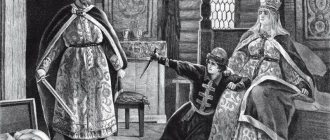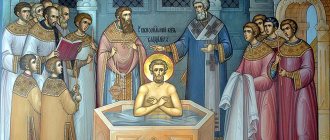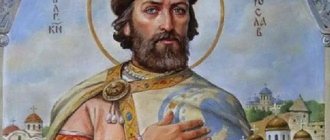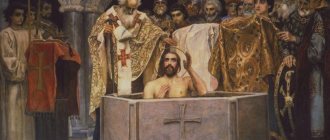It is not possible to calculate the exact number of wives and, especially, other connections of Vladimir I Svyatoslavich - the Grand Duke was too loving, according to the chronicler:
Vladimir was overcome by lust, and he had wives: Rogneda, whom he settled on Lybid, where the village of Predslavino is now located, from her he had four sons: Izyaslav, Mstislav, Yaroslav, Vsevolod, and two daughters; from a Greek woman he had Svyatopolk, from a Czech woman - Vysheslav, and from another wife - Svyatoslav and Mstislav, and from a Bulgarian woman - Boris and Gleb, and he had 300 concubines in Vyshgorod, 300 in Belgorod and 200 in Berestov, in the village, which They call it now Berestovoe. And he was insatiable in fornication, bringing married women to him and corrupting girls [1]Excerpt from the Tale of Bygone Years about Prince Vladimir I Svyatoslavich.
Restoring the exact chronology of Vladimir’s connections with different women is also problematic.
Anna's personality
Princess Anna of Byzantium was born into the family of Emperor Roman II in 963. My father had to rule for only 4 years. The girl's mother was an ordinary girl of Armenian origin. Roman died a few days after the birth of his daughter. The commander Nikifor Phokas, whom Anna's mother Feofano married, came to power. In 969 there was a coup d'état. Another military leader, John Tzimiskes, became emperor. He expelled Anna and her mother from the capital.
The girl returned to Constantinople only after her older brothers took the throne. Anna was an enviable European bride, who was expected to be the wife of many monarchs. Relatives treated the princess as an important political card and were in no hurry to marry her off.
Dynastic marriages at that time were an integral part of state affairs. Anna was a valuable wife not only because she came from the reigning Byzantine dynasty, but also because the girl received the best education that that era could give her. Contemporaries gave the bride the nickname Rufa (Redhead).
Enviable bride
Since 976, two brothers of Anna ruled in Constantinople - Vasily II the Bulgarian Slayer and Constantine VIII. European sources of the time have confusing evidence about which of the Christian monarchs wooed the Byzantine princess before the Slavic prince Vladimir.
In 988, ambassadors from Paris arrived in Constantinople. The French king Hugh Capet was looking for a bride of equal dynastic stature for his son Robert II. The mission of envoys to Byzantium was of great importance for this monarch. His Capetian dynasty had just begun to rule and needed to emphasize its legitimacy. Robert was 9 years younger than Anna, but the age difference at that time was rarely taken into account when the issue concerned politics. For unknown reasons, the marriage arrangement fell through, and the girl remained in her homeland.
Vladimir's matchmaking
How Anna of Byzantium married Vladimir of Kyiv is best known thanks to The Tale of Bygone Years. According to this document, the Slavic prince went with an army to Crimea, which belonged to the empire. On the peninsula, Vladimir captured the important city of Korsun. Rurikovich threatened Emperor Vasily in a letter that he would attack Constantinople if he did not marry his younger sister to him.
Anna of Byzantium agreed to the marriage, but at the same time announced her condition. She demanded that Vladimir be baptized according to the Greek Orthodox model. For the inhabitants of the empire, the Slavs were wild pagans from the northern steppes. In the Greek chronicles of that time they were even called Tauri and Scythians.
Organizing Anna's move took several months. The brother-emperors hoped that they could gain time and offer Vladimir other conditions. However, the Slavic prince firmly insisted on his own. To be more convincing, he again promised to go with the army to the capital of the empire. When news of this threat reached Constantinople, Anna was hastily put on a ship.
LiveInternetLiveInternet
The most famous wife of Grand Duke Vladimir Svyatoslavovich, Anna of Byzantium, married him in 988 on the eve of the baptism of Rus'. She was the daughter and sister of the emperors who reigned in Constantinople.
Anna's personality
Princess Anna of Byzantium was born into the family of Emperor Roman II in 963. My father had to rule for only 4 years. The girl's mother was an ordinary girl of Armenian origin. Roman died a few days after the birth of his daughter. The commander Nikifor Phokas, whom Anna's mother Feofano married, came to power. In 969 there was a coup d'état. Another military leader, John Tzimiskes, became emperor. He expelled Anna and her mother from the capital.
The girl returned to Constantinople only after her older brothers took the throne. Anna was an enviable European bride, who was expected to be the wife of many monarchs. Relatives treated the princess as an important political card and were in no hurry to marry her off.
Dynastic marriages at that time were an integral part of state affairs. Anna was a valuable wife not only because she came from the reigning Byzantine dynasty, but also because the girl received the best education that that era could give her. Contemporaries gave the bride the nickname Rufa (Redhead).
Enviable bride
Since 976, two brothers of Anna ruled in Constantinople - Vasily II the Bulgarian Slayer and Constantine VIII. European sources of the time have confusing evidence about which of the Christian monarchs wooed the Byzantine princess before the Slavic prince Vladimir.
In 988, ambassadors from Paris arrived in Constantinople. The French king Hugh Capet was looking for a bride of equal dynastic stature for his son Robert II. The mission of envoys to Byzantium was of great importance for this monarch. His Capetian dynasty had just begun to rule and needed to emphasize its legitimacy. Robert was 9 years younger than Anna, but the age difference at that time was rarely taken into account when the issue concerned politics. For unknown reasons, the marriage arrangement fell through, and the girl remained in her homeland.
Vladimir's matchmaking
How Anna of Byzantium married Vladimir of Kyiv is best known thanks to The Tale of Bygone Years. According to this document, the Slavic prince went with an army to Crimea, which belonged to the empire. On the peninsula, Vladimir captured the important city of Korsun. Rurikovich threatened Emperor Vasily in a letter that he would attack Constantinople if he did not marry his younger sister to him.
Anna of Byzantium agreed to the marriage, but at the same time announced her condition. She demanded that Vladimir be baptized according to the Greek Orthodox model. For the inhabitants of the empire, the Slavs were wild pagans from the northern steppes. In the Greek chronicles of that time they were even called Tauri and Scythians.
Organizing Anna's move took several months. The brother-emperors hoped that they could gain time and offer Vladimir other conditions. However, the Slavic prince firmly insisted on his own. To be more convincing, he again promised to go with the army to the capital of the empire. When news of this threat reached Constantinople, Anna was hastily put on a ship.
The circumstances of Anna's arrival
Even before the Crimean events, a military mutiny of the influential commander Vardas Phocas took place in Byzantium. The two brother emperors found themselves in a precarious position. When, among other things, they were attacked by the Slavic prince, they agreed to accept his conditions concerning the marriage to Anna. Vladimir, according to pagan custom, had many concubines. However, it was not without reason that he chose the Byzantine princess. Rumors about personal merits spread among diplomats of all European countries. They also reached Kyiv. For Vladimir, a wedding to the sister of the Byzantine emperor was not only a family affair, but also a matter of reputation.
According to Greek chronicles, Anna treated her inevitable marriage as a public duty. In essence, she sacrificed herself to the ambitions of the prince of a wild country. The princess did not want a destructive war for her homeland and therefore agreed to leave for Kyiv. At that moment, she probably did not expect happiness in Rus'.
Wedding with a Slavic prince
The Byzantine princess Anna, when meeting with her chosen one, persuaded him to accept Christianity as soon as possible. The prince was indeed baptized very soon. After this, the couple was married in 988. Vladimir made peace with the Byzantine emperor and returned Korsun to him.
When the sovereign returned to Kyiv, he ordered to get rid of pagan idols and baptize all compatriots. The adoption of Christianity became an important state step for Vladimir, which he decided to take even before the start of the war with Byzantium. The campaign was only an excuse for him to speak with Vasily on an equal footing.
Christian marriage
With the help of the capture of Korsun, the Kiev prince achieved two important things. Firstly, Princess Anna of Byzantium became his wife, which made him related to the powerful Greek dynasty. Secondly, Orthodoxy was adopted, which soon united the whole country. Before this, the Eastern Slavs were divided into several tribal unions that lived separately from each other. They not only had their own customs, but also gods. Pantheons often differed from each other. Christianity became an important religious anchor that created the Russian nation.
Anna of Byzantium (wife of Prince Vladimir) contributed to the spread of her native faith in a foreign country. The husband often consulted with his wife on religious matters. On her initiative, several churches were built. Particularly important was the Kiev Cathedral in honor of the Dormition of the Virgin Mary. Later it was nicknamed the Church of the Tithes due to the fact that a tenth of the prince's income was spent on it. Together with Anna, numerous Greek missionaries and theologians came to the Russian lands.
Founder of the Tithe Church
There is much evidence that the daughter of the Byzantine emperor Anna became the founder of the Tithe Church in Kyiv. The temple was dedicated to the Virgin Mary, which hints that the initiator of its creation was a woman. Anna wanted the new building to have the architecture of Constantinople that was familiar to her.
The Tithe Church is often compared to the two great Byzantine churches - Blachernae and Pharos. She appeared next to Anna's palace in Kyiv. The climate of this city suited the Greek princess much more than the environment of northern Novgorod, where Vladimir himself was from and where he spent his youth. His wife rarely left the southern capital. Rich Greek gifts from their homeland were brought there from Kherson, which replenished Anna’s own treasury. Byzantine architects and craftsmen came from Crimea to help implement the project of the new Tithe Church.
Anna's death
Slavic prince Vladimir and Anna of Byzantium were married for 22 years. However, during this time they never had children. Vladimir's sons, who later inherited his power, were offspring of the monarch's previous connections. Being a pagan, Vladimir had his own harem and concubines. When the prince married a Greek princess, he left his old life behind.
Anne died in 1011 at the age of only 48. It is not known exactly what caused her death. Most likely, it was a disease caused by an epidemic. For Vladimir it was a heavy loss. After the death of his wife, he himself lived only a short time and died in 1015.
A marble sarcophagus was made for Anna. It was made by Greek craftsmen who decorated their creation with unique carvings. It was decided that Anna of Byzantium would be buried in the Tithe Church. Armenian by origin, she was born and raised in Byzantium, and lived her adult life in Rus', where she died. A few years later, Vladimir was buried next to his wife. Their tombs were destroyed in 1240, when the Tatars captured and razed Kyiv.
The meaning of marriage for Vladimir
Marriage to Anna exalted Vladimir. Some foreign chroniclers began to call him king, according to the title of his wife. It was under him that Rus' finally became part of Christian Europe and the civilization there. At the same time, we should not forget that Vladimir, while still a pagan, considered the possibility of converting to Islam or Judaism for state purposes. But in the end he chose Orthodoxy.
It was the Byzantine princess Anna (the wife of Prince Vladimir) who helped him not to become dependent on the Byzantine emperor after adopting Christianity. On the contrary, the Kiev ruler found himself on the same level as the Constantinople monarch.
Russian Church without Anna
Anna's death markedly hit the young Russian Church. In 1013, Vladimir's stepson Svyatopolk, who laid claim to the future supreme power in Rus', married the daughter of Boleslav I, the Polish king and political opponent of the Kyiv princes. Preparations even began for the creation of the Turov Catholic Diocese. However, Vladimir did not tolerate his stepson’s defiant behavior. He arrested Svyatopolk and expelled Catholic missionaries from the country.
Vladimir's son Yaroslav the Wise paid a lot of attention to religious issues. Under him, the Kiev metropolis was created, and the first Russian hierarch Hilarion appeared. All these events somewhat overshadowed the important role played by Anna of Byzantium in the Christianization of Rus'. Metropolitan Hilarion did not like the Greek influence on the church and therefore did everything to prevent the chroniclers from talking too much about the activities of Vladimir’s wife. This is largely due to the paucity of Russian sources telling about Anna.
Author: Maxim Novichkov
via
The circumstances of Anna's arrival
Even before the Crimean events, a military mutiny of the influential commander Vardas Phocas took place in Byzantium. The two brother emperors found themselves in a precarious position. When, among other things, they were attacked by the Slavic prince, they agreed to accept his conditions concerning the marriage to Anna. Vladimir, according to pagan custom, had many concubines. However, it was not without reason that he chose the Byzantine princess. Rumors about personal merits spread among diplomats of all European countries. They also reached Kyiv. For Vladimir, a wedding to the sister of the Byzantine emperor was not only a family affair, but also a matter of reputation.
According to Greek chronicles, Anna treated her inevitable marriage as a public duty. In essence, she sacrificed herself to the ambitions of the prince of a wild country. The princess did not want a destructive war for her homeland and therefore agreed to leave for Kyiv. At that moment, she probably did not expect happiness in Rus'.
Rogneda
Of all Vladimir’s wives, two can be singled out that especially vividly characterize the two sides of his contradictory nature: the unbridled and cruel barbarian before baptism and the equally ardent and uncompromising Christian neophyte who received the name Vasily in baptism. We are talking about the daughter of the Polotsk prince Rogneda and the sister of the Byzantine emperor Anna.
Vladimir wooed Rogneda when he was very young. He was already married by that time, but for a pagan this was not an obstacle, because, as already mentioned, our ancestors were polygamous before the adoption of Christianity.
Rogneda preferred his brother Yaropolk, and rejected Vladimir, saying: “I don’t want rozuti robichich.” The most important part of the wedding ceremony among the Slavs was the moment when the bride took off her groom’s shoes as a sign of submission. So, proud Rogneda did not want to kneel down and take off the “robicic”’s shoes.
But Vladimir Svtoslavich was not one of those who would be satisfied with such an answer. He came with his squad to Polotsk, burned the city, raped Rogneda in front of her parents, and then killed Rogneda’s father, mother and brothers. The poor thing would probably have been glad to die too, but the cruel Kiev resident doomed her to a different fate. He made her his legal wife, and she was forced to bear the bonds of this hateful marriage and give birth to children for the prince.
However, Rogneda’s proud disposition still made itself felt. Once, during one of Vladimir’s visits, when the prince fell asleep on the bed of love, Rogneda set out to stab the sleeping ruler. But how can a woman cope with such a seasoned warrior as Vladimir was?
He instantly woke up and caught the hand with the raised dagger. Angry, he ordered his wife to prepare for death. At the same time, he decided to execute Rogneda with barbaric sophistication. The prince ordered Rogneda to dress up as for a wedding and wait for him, sitting on the wedding bed. If you don’t want to live with the prince as a submissive wife, then I’ll marry you with death! Rogneda obediently fulfilled all the conditions of her husband, but managed to talk with Izyaslav, her seven-year-old son from Vladimir.
And so, breathing anger and rage, Vladimir crosses the threshold of the upper room, where Rogneda is waiting for him, draws his sword, and then a boy steps towards him, also with a sword in his hands. He is still small, and the sword is still too heavy for his hands. But the kid bravely says to Vladimir: “Do you remember that you are alone here, father?” (Do you think you are alone here, father?). And the cruel warrior, the barbarian, raised in the Varangian squad ... retreated in front of the child. Lowering his sword, he could only say: “Who thought you were here?” (Who thought you were here?).
In general, Prince Rogneda forgave. And, judging by the fact that after Izyaslav she gave birth to her husband two more sons, one of them the famous Yaroslav the Wise, and two daughters, further family life went well.
Wedding with a Slavic prince
The Byzantine princess Anna, when meeting with her chosen one, persuaded him to accept Christianity as soon as possible. The prince was indeed baptized very soon. After this, the couple was married in 988. Vladimir made peace with the Byzantine emperor and returned Korsun to him.
When the sovereign returned to Kyiv, he ordered to get rid of pagan idols and baptize all compatriots. The adoption of Christianity became an important state step for Vladimir, which he decided to take even before the start of the war with Byzantium. The campaign was only an excuse for him to speak with Vasily on an equal footing.
Childhood
After the death of Emperor Roman, as a result of palace intrigues, the commander Nikephoros II Phocas took possession of the throne, having married Theophano. Thus, Anna's mother, who became regent over her sons, tried to protect herself and her children from the attacks of the insidious nobility. But six years later, she again organized a conspiracy, this time against Nicephorus, with the help of her next lover, John Tzimiskes, an associate of her gullible husband. The emperor was treacherously killed in his bed, and Tzimiskes became the new ruler. However, he did not marry Feofano, but treacherously sent her to a remote island lost in the Aegean Sea. Young Anna also went there with her mother.
Coronation of John Tzimisces
While in exile, the young princess became interested in studying the rich heritage of her paternal ancestors. Her grandfather, Emperor Constantine VII, left to his descendants a huge number of works on medicine, history and other sciences. She carefully studied his descriptions of the lives of saints, illustrated with artistic miniatures of amazing beauty and grace. From the chronicles, Anna learned that her grandfather was not alien to the interests of the common people. During his reign, he built hospitals and shelters for the needy, organized the distribution of alms, took an interest in the fate of the convicted, and suppressed the abuses of officials.
Anna also studied the treatises of her great-great-grandfather Vasily I, intended for his son Emperor Leo I the Wise, from which she also learned a lot of interesting and useful things.
Anna of Byzantium
After the death of Tzimiskes in 976, power passed to Theophano’s sons Vasily and Constantine, who allowed Anna and her mother to return to the palace, however, the empress was not allowed to take power and wanted to rule themselves. Their reign was remembered for incessant wars and rebellions. In addition to the strife within the country, Constantinople itself was faced with an external threat. The Russian prince Vladimir Svyatoslavovich threatened to take possession of the Byzantine capital, and the forces of the emperors were running out. As a result, the brothers promised to give him Princess Anna as his wife, provided that Vladimir would provide them with military assistance and accept Christianity.
Anna by that time had turned into an enviable bride and a real beauty; her hand was sought by the heir of the Roman Empire, the son of the French king and the Bulgarian prince. Marriage to a foreigner and barbarian was an unheard-of humiliation for a girl, but the brothers managed to persuade her.
Christian marriage
With the help of the capture of Korsun, the Kiev prince achieved two important things. Firstly, Princess Anna of Byzantium became his wife, which made him related to the powerful Greek dynasty. Secondly, Orthodoxy was adopted, which soon united the whole country. Before this, the Eastern Slavs were divided into several tribal unions that lived separately from each other. They not only had their own customs, but also gods. Pantheons often differed from each other. Christianity became an important religious anchor that created the Russian nation.
Anna of Byzantium (wife of Prince Vladimir) contributed to the spread of her native faith in a foreign country. The husband often consulted with his wife on religious matters. On her initiative, several churches were built. Particularly important was the Kiev Cathedral in honor of the Dormition of the Virgin Mary. Later it was nicknamed the Church of the Tithes due to the fact that a tenth of the prince's income was spent on it. Together with Anna, numerous Greek missionaries and theologians came to the Russian lands.
In crimson and gold
In addition to appearance, as a rule, the bride’s family is also of interest. Anna was fine with this. Belonging to the Byzantine imperial dynasty is the highest test of birth for the Middle Ages. It is simply impossible to find any higher - any representative of any royal house of Europe was, in comparison with the Byzantine dynasty, not even a commoner, but yesterday’s monkey, which barely climbed down from the tree.
However, Anna stood out even in her family. She was purplish. This is a special category of representatives of the ruling house of the Roman Empire.
Article on the topic
The last flower of Byzantium. 10 facts about the Russian Tsarina Sophia Paleologue
Porphyrogenites - this is the name given to the emperor's children born during his reign. All of them were born only and exclusively in the Porphyry (Crimson) Hall of the Great or Holy Imperial Palace, which was founded by Constantine the Great . During the first year of life, they were swaddled in matching purple swaddles. For 1 kg of fabric for such diapers it was necessary to spend 200 grams. purple dye. That is, 30 thousand purple mollusks, from which this rare paint was extracted. For those who are not convinced by this figure, let us convert it into money. 1 silk diaper, dyed purple, cost up to 30 thousand solids. Or, if you prefer, about 6 thousand current dollars. Truly - golden children.
But that’s not even the main thing. And the fact that such a child was considered blessed. Simply for the reason that his parents were bearers of divine, sacred power.
Article on the topic
Why did the Byzantine Empire disappear?
Founder of the Tithe Church
There is much evidence that the daughter of the Byzantine emperor Anna became the founder of the Tithe Church in Kyiv. The temple was dedicated to the Virgin Mary, which hints that the initiator of its creation was a woman. Anna wanted the new building to have the architecture of Constantinople that was familiar to her.
The Tithe Church is often compared to the two great Byzantine churches - Blachernae and Pharos. She appeared next to Anna's palace in Kyiv. The climate of this city suited the Greek princess much more than the environment of northern Novgorod, where Vladimir himself was from and where he spent his youth. His wife rarely left the southern capital. Rich Greek gifts from their homeland were brought there from Kherson, which replenished Anna’s own treasury. Byzantine architects and craftsmen came from Crimea to help implement the project of the new Tithe Church.
Anna's death
Slavic prince Vladimir and Anna of Byzantium were married for 22 years. However, during this time they never had children. Vladimir's sons, who later inherited his power, were offspring of the monarch's previous connections. Being a pagan, Vladimir had his own harem and concubines. When the prince married a Greek princess, he left his old life behind.
Anne died in 1011 at the age of only 48. It is not known exactly what caused her death. Most likely, it was a disease caused by an epidemic. For Vladimir it was a heavy loss. After the death of his wife, he himself lived only a short time and died in 1015.
A marble sarcophagus was made for Anna. It was made by Greek craftsmen who decorated their creation with unique carvings. It was decided that Anna of Byzantium would be buried in the Tithe Church. Armenian by origin, she was born and raised in Byzantium, and lived her adult life in Rus', where she died. A few years later, Vladimir was buried next to his wife. Their tombs were destroyed in 1240, when the Tatars captured and razed Kyiv.
Merits
Returning with his young wife to Kyiv, Vladimir immediately baptized his sons in the spring, which later received the name Khreshchatyk. On August 1, the prince baptized the people of Kiev, calling all the inhabitants of the city to the banks of the Dnieper, and ordered the destruction of all pagan symbols.
Having converted to the Christian faith, Prince Vladimir renounced all his numerous previous wives and concubines and proclaimed Anna the only wife given to him by God.
Church of the Blessed Virgin Mary in Kyiv
Having become the Grand Duchess of Kyiv, Anna began to spread Christianity and build churches in Rus'. The first temple she founded was the Church of the Blessed Virgin Mary in Kyiv (Church of the Tithes), created in the image and likeness of her beloved Pharos Church of Anna in Constantinople. She brought into fashion elements of stained glass, which Byzantine masters used to decorate churches.
Thanks to her, the annual magnificent celebration of the Dormition of the Blessed Virgin Mary was introduced into church life. On the recommendation of his wife, Prince Vladimir purchased a monastery for Russian Orthodox monks on Mount Athos.
Church Charter "Nomocanon"
Anna did not forget about educational activities, guided by the legacy of her great ancestors. The Greek church charter “Nomocanon” brought by her was laid as the basis of the Russian Church, and icons and church utensils became a model for copying by Russian icon painters and artisans. She created special educational institutions to train local clergy.
Thanks to Anna, Vladimir’s sons became imbued with the spirit of Christianity and began to actively introduce it among their subjects. Even the ex-wife of Prince Rogneda became a zealous Christian and founded the first convent in Rus', taking monastic vows there.
The meaning of marriage for Vladimir
Marriage to Anna exalted Vladimir. Some foreign chroniclers began to call him king, according to the title of his wife. It was under him that Rus' finally became part of Christian Europe and the civilization there. At the same time, we should not forget that Vladimir, while still a pagan, considered the possibility of converting to Islam or Judaism for state purposes. But in the end he chose Orthodoxy.
It was the Byzantine princess Anna (the wife of Prince Vladimir) who helped him not to become dependent on the Byzantine emperor after adopting Christianity. On the contrary, the Kiev ruler found himself on the same level as the Constantinople monarch.
Russian Church without Anna
Anna's death markedly hit the young Russian Church. In 1013, Vladimir's stepson Svyatopolk, who laid claim to the future supreme power in Rus', married the daughter of Boleslav I, the Polish king and political opponent of the Kyiv princes. Preparations even began for the creation of the Turov Catholic Diocese. However, Vladimir did not tolerate his stepson’s defiant behavior. He arrested Svyatopolk and expelled Catholic missionaries from the country.
Vladimir's son Yaroslav the Wise paid a lot of attention to religious issues. Under him, the Kiev metropolis was created, and the first Russian hierarch Hilarion appeared. All these events somewhat overshadowed the important role played by Anna of Byzantium in the Christianization of Rus'. Metropolitan Hilarion did not like the Greek influence on the church and therefore did everything to prevent the chroniclers from talking too much about the activities of Vladimir’s wife. This is largely due to the paucity of Russian sources telling about Anna.









